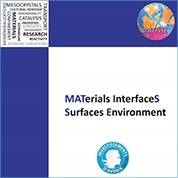MULTI-FUNCTIONAL MATERIALS AND ENVIRONMENT
Original strategies with improved environmental concerns for the design of functional materials
Axis 2 is focused on the development of materials with targeted properties based on nano-structuration and/or a controlled surface reactivity. Some exists, others have yet to be invented using nature as a model. Priority is given to synthetic processes based on "soft" chemistry, "green" chemistry and / or self-assembly. Modification and shaping are also of great concern in order to control the behaviour of the resulting materials in various environments. This comes into four sub-themes: “Bio‐inspired synthesis strategies”, “New biosensors”, “Tailoring surfaces” and “Green catalysts with improved performances”. Main application areas are in the fields of health (with the development of biosensors and biocompatible materials), environment (with the development of "green" catalytic processes) and energy (photovoltaic devices).
Partner Teams
LCMCP, LRS, INSP, LISE, RF@IFP-EN, PHENIX, IMPMC, CRC, IRCP.
Funded Projects
-2012 (PhD) - Grosso D. (LCMCP), Jardat M. et al (PHENIX) Conception and implementation of new systems for nanofluidic: experimental and theoretical studies.
-2012 (Post-Doc) - Launay F. (LRS), Gedeon A. (LCMCP) Porous supports with intrinsic chirality: Synthesis, advanced characterization and application to asymmetric catalysis.
-2013 (PhD) - Blanchard J. et al (LRS), Durupthy O. (LCMCP) Elaboration of bifunctional catalysts based on Pt supported onto heterostructures of zeolite and alumina.
-2013 (PhD) - Rouchon V. et al (CRC), Massiani P. et al (LRS) Understanding of cellulose depolymerisation mechanisms induced by transition metals.
-2014 (Post-Doc) - Lacaze E. (INSP), Dupuis V. et al (PHENIX) Magnetic modulation of plasmon anisotropy of gold nanoparticles.
None of the funded proposals does involve industrial partners yet. Among the on-going projects, two deal with the development of catalysts using new strategies for bi-functionality or for asymmetric induction; two with nanofabrication of devices for micro/nano fluidic applications and nano-assembly allowing tunable optical properties; one with the understanding of the degradation of a natural material.
Axis 2 was also at the initiative of the organization of a one-day scientific meeting in June 2013 entitled « Bottom-up approaches to nanotechnological device fabrication » in Orléans co-chaired par D. Grosso. In September 2013, Dr Eero Kontturi from the Department of Forest Products Technology of Aalto University was hired for one month as a visiting professor. He gave a series of seminars in the field of cellulose valorisation that also interested chemists affiliated to the Labex MICHEM.
Highlights
- Project with D. Grosso (LCMCP) and M. Jardat (PHENIX) as co-P.I. - PhD work of D.R. Ceratti.
Figure 2 : PhD work of D.R. Ceratti [see 3]
Pillared Planar Nanochannels (PPNs, Fig. 2a) obtained from the combination between self-assembly of block-copolymers and sol-gel techniques allow tunable pillar height, periodicity, inner porosity and chemical composition. In the project dealing with the nanofabrication of porous networks such as nanopillars structures (nano-in-micro) using chemical approaches, the objective was to show that the resulting PPNs are ideal systems for the the understanding of nanofluidic phenomena. Among their main findings, D. Grosso et al [1, 2] were able to emphasize relationships between capillary filling of water into these porous media and PPNs composition by studying the structural and dynamic properties of confined aqueous solutions with computational models (Fig. 2c).
The governing laws for these phenomena have been inspected and analyzed and the differences from macroscopic laws have been investigated. The devices (Fig. 2b) allow also the inspection of the main parameters of ions and fluorophores separation as well as of nanoconfined reactions. They were used in particular for separation of various fluorophores and labeled proteins and for nanoconfined reactions of Ru species (Fig. 2d) and fluorophores.
- Project with V. Rouchon (CRC) and P. Massiani (LRS) as co-P.I. - PhD work of A. Gimat.
Understanding the mechanisms of cellulose depolymerisation induced by transition metals is a common concern of researchers involved in the preservation of historical manuscripts (CRC) as well as those working on the catalytic upgrading of biomass resources (LRS). The first would like to stop the process; the second would like to improve it. At this stage, reactive oxygen species (ROS) differing from hydroxyl radicals and whose quantity varies with that of Fe(II) leached by inked paper were highlighted by EPR.
In parallel, studies with cellobiose (an oligomer used as a model of cellulose) monitored by IR spectrometry have highlighted the influence of oxygen, acidity and the amount of iron in the degradation process. Last objective will be to use the iron-based catalysts to the oxidative decomposition of cellulose.
Figure 3: PhD work of A. Gimat [4].
Benefits of MATISSE
Overall, axis 2 has highlighted unprecedented partnerships (LCMCP and PHENIX; CRC and LRS). This has helped to achieve in particular new PhD projects between teams not necessarily affiliated to the same Doctoral Schools.
Also MATISSE has supported registration fees for PhD students to attend CatPrep2014 in May 2014, a new and successful Catalysis School labelled by CNRS and organized by MATISSE members from LRS.
Also in the section
Key figures
MATISSE :
4 disciplines
- Chemistry
- Physics
- Earth Science
- Cultural heritage
18 partners
400 researchers
Contact
Direction :
Florence Babonneau
Administration :
Laurence Bonnet-Lericque
Communication :
Tél. (33) 1 44 27 62 36




